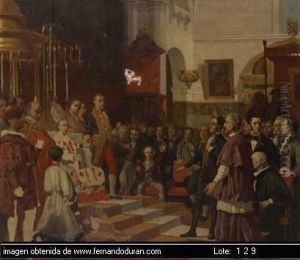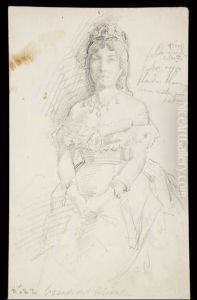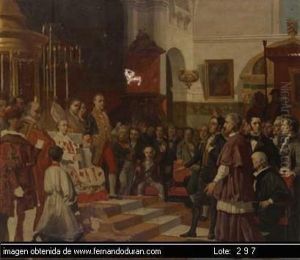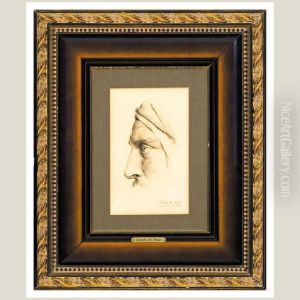Jose Maria Casado Del Alisal Paintings
José María Casado del Alisal was a prominent Spanish painter known for his historical and portrait paintings. Born on October 8, 1832, in Villada, Palencia, Spain, Casado del Alisal developed an interest in art from an early age. He began his formal education in the arts at the Royal Academy of Fine Arts of San Fernando in Madrid. His talent was recognized early on, and he was awarded a scholarship to further his studies in Rome, which was a pivotal experience in his artistic development.
During his time in Italy, Casado del Alisal was exposed to the works of the Italian masters and the Nazarene movement, which influenced his style. He absorbed elements of Romanticism, which was evident in his dramatic compositions and his handling of light and color. After completing his education, he traveled through Europe, including a stay in Paris, where he was influenced by the French academic painting tradition.
Casado del Alisal achieved significant recognition with his historical works. One of his most acclaimed paintings is 'La rendición de Bailén' (The Surrender of Bailén), which portrays the capitulation of French troops to Spanish forces during the Peninsular War. This painting won him the Medal of Honor at the National Exhibition of Fine Arts in Spain and was instrumental in establishing his reputation. Another notable work is 'La campana de Huesca' (The Bell of Huesca), depicting a dramatic medieval legend involving the King of Aragon.
Aside from historical scenes, Casado del Alisal was also a respected portraitist, capturing the likenesses of notable figures of his time with elegance and precision. His portraits are characterized by their refined technique and psychological depth, which won him commissions from the Spanish aristocracy and the intellectual elite.
Throughout his career, Casado del Alisal held various positions of influence in the art world. He was appointed as the director of the Spanish Academy in Rome, a prestigious role that allowed him to mentor the next generation of Spanish artists. His impact on Spanish art was significant, and his works continue to be admired for their historical value and artistic merit.
José María Casado del Alisal died on October 8, 1886, in Madrid. His legacy is preserved in numerous Spanish institutions, and his works are displayed in museums such as the Museo del Prado, where they remain a testament to his skill and contribution to the art history of Spain.




